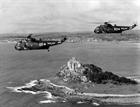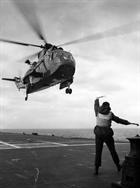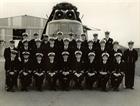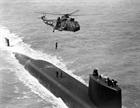Trio of Sea Kings reach 45 yrs service
In true Naval fashion a small glass has been raised at Royal Naval Air Station Culdrose in celebration of the remarkable careers of three of its legendry SeaKing helicopters.
The trio have each clocked up over 45 years of Fleet Air Arm service and were among the first batch to arrive on 700 (Sea King) Naval Air Squadron (700 (S) NAS at RNAS Culdrose in August 1969.
Built by Westland Helicopters at Yeovil, these Sea Kings was originally designated Helicopter Anti-submarine Mk 1s (HAS Mk 1) and have morphed through several configurations over their long and distinguished careers. Two are now Sea King Mk 5s, XV 647, and XV 648 with 771 NAS for Search and Rescue duties and XV 649 has been modified into a Mk 7 ASaC, the Airborne Surveillance version of the Sea King. All three are still operational and still pulling their weight on the flight-line.
700 (S) NAS with Lieutenant Commander Vic Sirett as Commanding Officer took delivery of six Sea King HAS 1s for trials and development. Each aircraft went on to achieve over400 hours flying in their primary Anti-submarine role in addition to load lifting, Search & Rescue, deck landings, troop carrying and the use of the general purpose machine gun. By the beginning of 1970 the Sea King had started to enter operational service. 706 Squadron received the new aircraft in January to replace its Wessex Mk 3s and the first front line squadron to operate the type, 824Squadron reformed on 24February.
The Sqn disbanded in May 1970 shortly after Vic Sirett demonstrated in XV 649 the Sea King’s long range capability, flying non-stop from Lands End to John O’Groats, a distance of nearly 700 miles in 4 hours and 19 minutes. For the flight and the successful introduction of the Sea King into RN Service, Lt Cdr Vic Sirett was awarded the Boyd trophy for 1970. By June 826 Squadron reformed with the Sea King and 824 Squadron embarked HMS Ark Royal for the aircraft’s first operational deployment.
The service histories of these particular Sea Kings are testament to the versatility of the aircraft over the years. Beginning as HAS Mk 1’s they were upgraded to HAS Mk2s in the 70s and then two were converted to HAS Mk5s and XV 649 to an Airborne Early Warning asset then a Sea King ASaC Mk 7, the final variation of Sea King.
“These aircraft were built from 1950s technology, the hydraulic systems are as reliable today as they were in 1969, which could these days be considered simple technology, however if it ain’t broke don’t fix it”, said Warrant Officer Ian Mitchell ,WO Engineer with 771 NAS and has worked on Sea Kings for most of his Naval career. “XV647 and XV648 have stood the test of time well, they’ve transformed from Mk 1s to Mk 5s having all sorts of modifications fitted and removed, even to this day we are still fitting new equipment”.
MaritimeSeaKing Commander at RNAS Culdrose, CDR Vee Dale-Smith, herself a Sea King pilot has flown them at Culdrose and on Operations in the Middle East. “As the Sea King comes to the end of its service with the Fleet Air Arm, these three Aircraft typify the excellence of the original concept and design. Over the past 45 years these three in particular have served all over the world on operations and embarked on all Royal Navy’s capital ships. Without doubt, everyone who has had the privilege to work with the Sea King over the years has developed a unique bond and loyalty to this fabulous helicopter and will have many an interesting tale to tell of their experiences”.
Between the three they have nearly amassed 50,000 flying hours which has seen them flown across the world where ever the Fleet Air Arm has ventured; from Carrier Task Group tasking in the Falkland’s during 1982 to providing “Over-watch” during 2014in Afghanistan, flying in temperatures that range from minus 35 degrees in the Arctic to over plus 50 degrees in desert conditions.
Sea King helicopters will be decommissioning over the next two years from the Fleet Air Arm and replaced by New Merlin Mk 2s and “Merlin Crowsnest” - which will take over the Airborne Surveillance task for the Fleet, serving on the Queen Elizabeth Class carriers.






